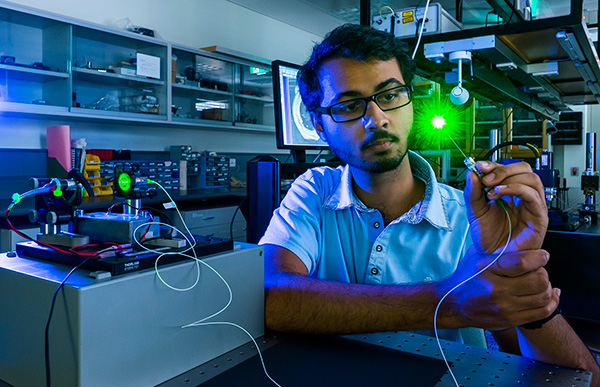UWA and me
My introduction to UWA was as an undergraduate in engineering and in biological sciences. I have always been interested in learning how things work, be it technology or the human body. UWA provided me with the perfect opportunity to look from two different perspectives. On one hand, to learn the fundamental engineering principles that take simple parts and build them into complex machines, and on the other, to study the human body – a machine already built – and to discover what makes us tick. Through my journey at UWA, I found how much is still undiscovered. After my undergraduate degree, moving from ‘learning’ to ‘doing’, I started a PhD with the Optical+Biomedical Engineering Laboratory. It has been one of the most fulfilling and interesting experiences at UWA. I was able to bring together everything that I’d learned to develop novel engineering tools and uncover new biological insights. Now, having completed my PhD, and still at UWA, I have started as a researcher in the Bioimaging Research and Innovation for Translational Engineering Laboratory.
The merger of engineering and biology
The merger of engineering and biology, two different worlds, feeds my curiosity and is a source of discovery and inspiration.
Particularly, my passion lies in studying single cells, the fundamental units of life. If we can understand how they work, we come ever closer to understanding disease, developing effective treatments, and engineering our own tissues. Cells are tiny, so we are limited by our current technology in how we can observe and interact with them; and they are social, so we struggle to provide them the right environment and cues so they will behave as if they were in their natural body. My interests are in developing new technology that may interact with cells and observe their behaviour in their natural environment. My other passion is the accessibility of science. Particularly, making cheap and easy to use tools to aid medicine and biology. There are many technologies that have the potential to improve health that do not find purchase in mainstay medicine due to costs or regulations. Making low cost devices can relieve much of the strain of current healthcare and empower individuals to take their health into their own hands.
Broadening of our knowledge in cellular biomechanics
Throughout my research career I have been working primarily on the development and application of optics-based bioimaging devices used to study the biomechanics of tissues and cells. The most interesting aspect of my research is applying developed technology to study the reciprocal nature of cellular development, where growing cells construct their own scaffold upon which to grow and develop further. There is capacity for us, or a disease, to alter these processes, creating structurally and functionally different tissues. The development of the tools to do this, and the broadening of our knowledge in cellular biomechanics, have great potential for improving disease detection and characterisation, evaluating treatment strategies, and tissue engineering.
BioHack Academy
I have been engaged in a number of outreach, public and educational activities. Perhaps the largest was coordinating the ‘BioHack Academy’ (BHA) at UWA. BHA is run annually by the Waag society, Netherlands, with partnered labs around the world. Thanks to an Alumni Fund Grant in 2017, UWA was among the participants. The 8-week academy featured lectures and practical sessions, from genetic engineering and 3D printing to bioethics and bioart. BHA has been a test and a show of what can be achieved when biologists, artists, engineers and designers come together in one room. The results were beyond my expectations – artists and biologists building microelectronics and engineers exploring bioethics and growing bacteria. Together we built cheap microscopes, incubators, and centrifuges, and grew biofuels and biotextiles. Beyond the academy we have started a ‘do-it-yourself biology’ group in Perth.
I am also the current president of The Optical Society Student Chapter of UWA. Thanks to all its members and affiliates, we have hosted a number of year-round events and networking opportunities for students and the public, including talks by distinguished academics, educational laser shows, events at SciTech, and hands-on workshops for high school students on how to build your own microscope.
You can get involved and find out more about these projects through the OSA Student Chapter of The University of Western Australia Facebook page or DIYBio Perth Facebook group.
About Philip
Philip is a Research Associate at the Bioimaging Research and Innovation for Translational Engineering Laboratory (BRITElab) in the Harry Perkins Institute of Medial Research, UWA. He is working on new bioimaging platforms to observe and characterise biological tissues, with applications spanning from diagnosis and surgery to tissue engineering and fundamental cellular biophysics. He has completed his PhD in the Optical+Biomedical Engineering Laboratory (OBEL), developing new methods and applications of optical elastography, the optics-based characterisation of tissue biomechanics. This was preceded by a Bachelor of Electrical and Electronic Engineering and Physiology at UWA. He is heavily involved in science outreach, as the president of The Optical Society Student Chapter of UWA, and as a member of ‘do-it-yourself bio’ in Perth.